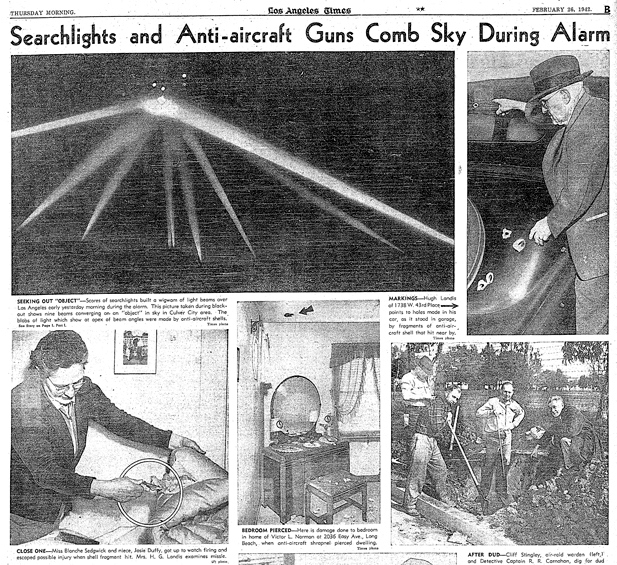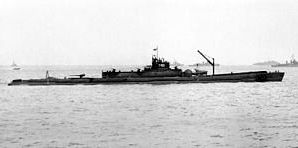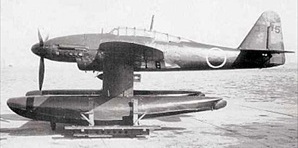JAPANESE SUB SHELLS U.S. WEST COAST
Santa Barbara, California · February 23, 1942
Japanese submarines initiated the first shore bombardments of the war with an attack on the U.S. Navy base at Johnston Island in the Pacific in mid-December 1941, just days after Japanese carrier-based planes had destroyed, in their surprise attack on Pearl Harbor, Hawaii, one half of the United States’ naval power. Japanese submarines briefly shelled the American Pacific outpost on Midway Island in January 1942. The following month, on this date in 1942, Japanese submarine I‑17 made the first enemy attack on the U.S. mainland since the War of 1812. Shortly after 7 p.m., the I‑17 surfaced several hundred yards off a beach west of Santa Barbara, California, and for the next 20 minutes fired 17 rounds from her 140mm gun at the Richfield (now ARCO) aviation fuel storage tanks on the bluff top behind the beach. The shots missed the tanks but destroyed an oil derrick and damaged a pier and a pump house. News of the Ellwood oil field shelling triggered an invasion scare up and down the West Coast. The following night U.S. Army anti-aircraft batteries exploded into action over the blacked-out city of Los Angeles, California. During a 30‑minute fusillade, guns hurled 1,440 rounds of 3‑inch and 37mm ammunition into the searchlight-swept night sky. About 10 tons of shrapnel and dud shells fell back on the city of 1.5 million people, damaging residences, shipyards, and aircraft plants where late-night shifts were at work. Eight people died that night, three of heart attacks, the others in accidents related to the blackout. At a press conference shortly afterward, Secretary of the Navy Frank Knox called the incident, known in contemporary media as “The Battle of Los Angeles” or “The Great Los Angeles Air Raid,” a “false alarm” stemming from “war nerves.” Not everyone bought the government’s assurances. The Long Beach [California] Independent editorialized: “There is a mysterious reticence about the whole affair and it appears that some form of censorship is trying to halt discussion on the matter.” Others speculated that the incident was either staged or exaggerated to give defense industries like Douglas (now Boeing) Aircraft in Long Beach and nearby Santa Monica an excuse to move further inland. (Secretary Knox encouraged their moving.) The Great Los Angeles Air Raid was front-page news and fodder for newspaper editors around the nation. Truth was, as it turned out, during 1941 and 1942 the I‑17 was one of 10 Japanese submarines that routinely patrolled off the Pacific West Coast, Alaska, and Baja California.
[amazon_carousel widget_type=”ASINList” width=”600″ height=”200″ title=”Recommended Reading” market_place=”US” shuffle_products=”False” show_border=”False” asin=”1557500150,0955426812,1844154807,0770435734,1615775811,0936738871,0870216821,1846030900,1497498295,1927527538″ /]
Japanese Sub I-17 Brought War and Pandemonium to the U.S. Mainland. More Japanese Subs Were on Their Way to the West Coast
 |
Above: The February 26, 1942, Los Angeles Times edition covered the “Battle of Los Angeles” and its aftermath. Times headlines screamed: “ARMY SAYS ALARM REAL.” In a front-page editorial the newspaper stated that “considerable public confusion and excitement” had been caused by the air raid alert. In some of the most imaginative reporting of the war, articles described shrapnel-strewn areas of the city, property damage, and people finding unexploded ordinance. The rival Los Angeles Examiner described “shrapnel-strewn” neighborhoods that “took on the appearance of a huge Easter-egg hunt [as] youngsters and grownups alike scrambled through streets and vacant lots, picking up and proudly comparing chunks of shrapnel fragments.” The Army roped off the entire streets, placing large signs at both ends warning “UNEXPLODED BOMB.” There were no unexploded bombs—at least from Japanese aircraft—notwithstanding Secretary of War Henry L. Stimson’s public assertion that 15 enemy planes had overflown the city the previous night, possibly launched from secret Japanese airfields or submarines, and the Examiner’s spurious claim that three planes had been shot down over the ocean. After the war Japanese officials denied sending planes over Los Angeles on the night of the “Great Los Angeles Air Raid.”
 |  |
Left: The mammoth Sen-toku, or I-400-class submarine. Difficult though it is, note the long tube-like plane hangar on the sub’s aft deck and the forward catapult. Japanese plans called for building a fleet of 18 I-400-class submarines, at 400 ft long and displacing 6,670 tons, by far the largest and among the most deadly subs ever built until the 1960s. The subs were designed as underwater aircraft carriers, each equipped with three Aichi M6A1 seaplane bombers. Their mission was to travel more than halfway around the world (the I-400 had a range of over 30,000 nautical miles), surface off the North American or Panamanian coast, and launch their deadly air attack. Only three Sen-tokus were completed; two entered service without seeing combat.
![]()
Right: An Aichi M6A1 Seiran seaplane, the type carried aboard I-400-class subs. The brainchild of Adm. Isoroku Yamamoto, the architect of the Japanese naval attack on Pearl Harbor, the I-400-class submarine was designed to carry three Seirans (which translates as “storm from a clear sky”), each capable of carrying one 1,800‑lb bomb for up to 620 miles. The late-war I-400-class “wonder weapon” was unknown to U.S. intelligence, despite having broken the Japanese naval code.
Japan Sends Subs to Strike California, Oregon. Builds Aircraft-Carrying Super Submarines
![]()

 History buffs, there is good news! The Daily Chronicles of World War II is now available as an ebook for $4.99 on Amazon.com. Containing a year’s worth of dated entries from this website, the ebook brings the story of this tumultuous era to life in a compelling, authoritative, and succinct manner. Featuring inventive navigation aids, the ebook enables readers to instantly move forward or backward by month and date to different dated entries. Simple and elegant! Click
History buffs, there is good news! The Daily Chronicles of World War II is now available as an ebook for $4.99 on Amazon.com. Containing a year’s worth of dated entries from this website, the ebook brings the story of this tumultuous era to life in a compelling, authoritative, and succinct manner. Featuring inventive navigation aids, the ebook enables readers to instantly move forward or backward by month and date to different dated entries. Simple and elegant! Click 











